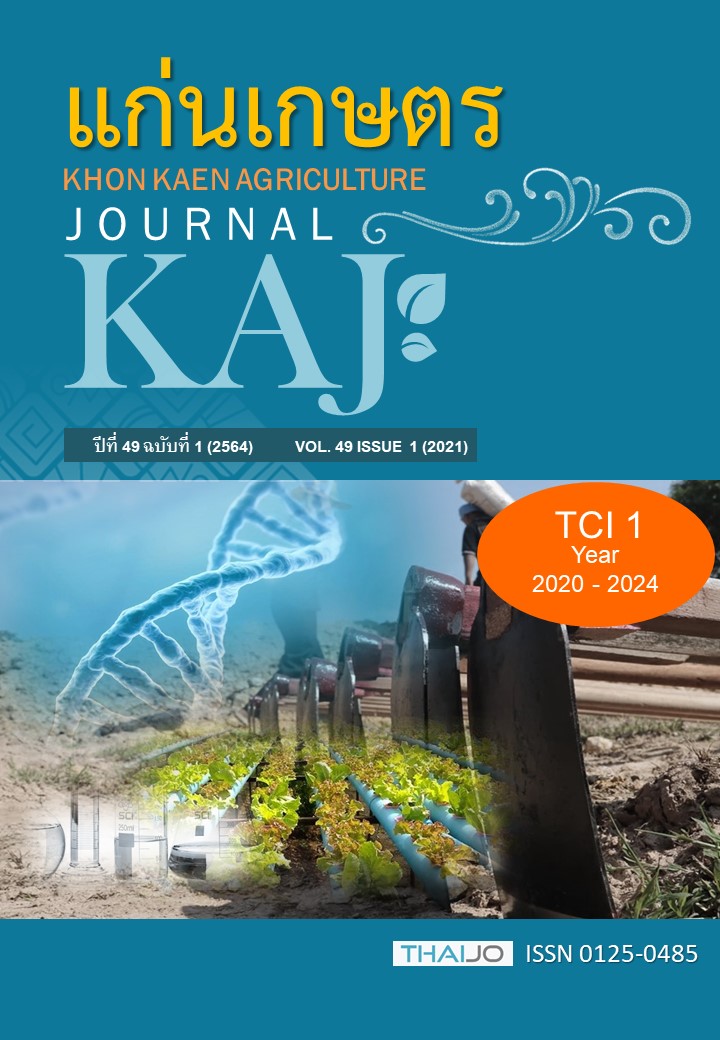การประยุกต์ใช้ผงเชื้อ Trichoderma asperellum ต่อการควบคุมโรคกาบใบแห้งของข้าวที่เกิดจาก Rhizoctonia solani
Main Article Content
บทคัดย่อ
การใช้ผงเชื้อรา Trichoderma เพื่อควบคุมโรคกาบใบแห้งของข้าว สาเหตุจากเชื้อรา R. solani เชื้อรา Trichoderma sp. แยกจากดินที่เพาะปลูกไม้ผล จ.จันทบุรี จำแนกเชื้อรา Trichoderma (MC2560) ตามลักษณะทางสัณฐานวิทยาและวิธีทางชีวโมเลกุล เปรียบเทียบลักษณะนิวคลีโอไทด์ที่บริเวณ ITS 4 และ ITS 5 จำแนกลักษณะที่คล้ายคลึงกันตรวจด้วยโปรแกรม BLAST พบว่าเชื้อราดังกล่าวมีความใกล้เคียงกับเชื้อรา Trichoderma asperellum QT22046 accession number KY225608 ที่ 98.58% การทดสอบการเป็นเชื้อราปฏิปักษ์ของเชื้อรา T. asperellum ต่อเชื้อรา R. solani ด้วยวิธี dual culture บนอาหาร Potato Dextrose Agar (PDA) พบว่าเชื้อรา T. asperellum สามารถยับยั้งการเจริญของเชื้อรา R. solani เท่ากับ 42.10% และเส้นใยของเชื้อรา T. asperellum เจริญคลุมทับโคโลนีของเชื้อรา R. solani เท่ากับ 0.56 เซนติเมตรต่อวัน การเจริญของเชื้อรา T. asperellum บนอาหาร PDA ที่อุณหภูมิแตกต่างกัน พบว่าที่อุณหภูมิ 25-30°C เชื้อราเจริญรวดเร็วเต็มจานอาหารเลี้ยงเชื้อ ภายใน 3 วัน แต่ไม่เจริญที่อุณหภูมิ 40°C ทดสอบประสิทธิภาพของผงเชื้อรา T. asperellum ในการควบคุมโรคกาบใบแห้งของข้าวในโรงเรือน เตรียมจากสารแขวนลอยสปอร์ในสารละลายบัฟเฟอร์ (0.2% carboxyl methyl cellulose 0.5% ไคโตซาน และ 1.0% tween80) ที่มี talcum เป็นสารพา การปลูกเชื้อรา R. solani บนต้นข้าวพันธุ์ กข41 อายุ 50 วัน ในโรงเรือนปลูกพืชเตรียมโดยนำ mycelium disc ผสมข้าวเปลือกและแกลบที่ฆ่าเชื้อแล้วใส่ในถุงกระดาษฟางห่อทับด้วยมุ้งลวดแล้ววางระหว่างลำต้นที่บริเวณระดับน้ำ นำผงเชื้อรา T. asperellum ที่ผสม talcum มาพ่นลงบนต้นข้าว พบว่าการพ่นผงเชื้อรา T. asperellum ความเข้มข้น 40 กรัมต่อน้ำ 20 ลิตร สามารถลดการเกิดโรคได้ 42.01% และ 37.31% หลังจากฉีดพ่น 14 และ 21 วัน ตามลำดับ เมื่อเปรียบเทียบชุดควบคุม (ปลูกเชื้อเพียงอย่างเดียว)
Article Details

อนุญาตภายใต้เงื่อนไข Creative Commons Attribution-NonCommercial-NoDerivatives 4.0 International License.
เอกสารอ้างอิง
ณรงค์ สิงห์บุระอุดม. 2558. การจัดการโรคพืช. พิมพ์ครั้งที่ 3. เอเชีย ดิจิทัล เพลส, กรุงเทพฯ.
นิพนธ์ ทวีชัย. 2550. การควบคุมโรคพืชโดยวิธีธรรมชาติ. บริษัทเท็กซ์เจอร์นัลพับลิเคชั่น จำกัด, กรุงเทพฯ.
บังอร น้อยใสย์, จิระเดช แจ่มสว่าง และวรรณวิไล อินทนู. 2561. ประสิทธิภาพของชีวภัณฑ์ Bacillus siamensis RRK1–Rif สูตรผงเปียกน้ำ ในการควบคุมโรคกาบใบแห้งและโรคเมล็ดด่างและการเพิ่มผลผลิตของข้าว. แก่นเกษตร. 46: 633–642.
ปัณณวิชญ์ เย็นจิตต์, ธิดา เดชฮวบ และวาริน อินทนา. 2561. การประยุกต์ใช้ร่วมกันของผงเชื้อ Trichoderma sp. และ Bacillus sp. ต่อการควบคุมโรคเมล็ดด่างที่เกิดจาก Bipolaris oryzae ในข้าว. วิทยาศาสตร์เกษตร. 49: 15–26.
พากเพียร อรัญนารถ, นงรัตน์ นิลพานิชย์, วิชิต ศิริสันธนะ และสมคิด ดิสถาพร. 2544. ประสิทธิภาพของชีวภัณฑ์ Bacillus subtilis ในการควบคุมโรคกาบใบแห้งของข้าว. วารสารวิชาการเกษตร. 19: 4–12.
วิชชุดา รัตนากาญจน์, รัศมี ฐิติเกียรติพงศ์, คะนึงนิจ ศรีวิไลย และสิทธ์ ใจสงฆ์. 2554. โรคข้าวและการป้องกันกำจัด. พิมพ์ครั้งที่ 2. สำนักวิจัยและพัฒนาข้าว กรมการข้าว, กรุงเทพฯ.
Abbas, A., D. Jiang, and Y. Fu. 2017. Trichoderma spp. as Antagonist of Rhizoctonia solani. Journal of Plant Pathology and Microbiology. 8: 1–9.
Benítez, T., M.A. Rincon, M.C. Limon, and C.A. Codon. 2004. Biocontrol mechanisms of Trichoderma strains. International Microbiology. 7: 249–260.
Boukaew, S. and P. Prasertsak. 2014. Suppression of rice sheath blight disease using a heat stable culture filtrate from Streptomyces philanthi RM-1–138. Crop Protection. 61: 1–10.
De Franca, S.K.S., A.F. Cardoso, D.C. Lustosa, E.M.L.S. Romos, M.C.C. De Filippi, and G.B. Da Silva. 2015. Biocontrol of sheath blight by Trichoderma asperellum in tropical lowland rice. Agronomy for Sustainable Development. 35: 317–324.
Gupta, A.K., M. Harish, M.K. Ria, M. Phulwaria and N.S. Shekhawat. 2011. Isolation of genomic DNA suitable for community analysis from mature trees adapted to arid environment. Gene. 487: 156–159.
Harman, G.E., C. R. Howell, A., Viterbo, I. Chet, and M. Lorito. 2004. Trichoderma species opportunistic, avirulent plant symbionts. Nature Reviews Microbiology. 2: 43–56.
Harman, G. E. 2006. Overview of mechanism and uses of Trichoderma spp. Phytopathology. 96: 190–194.
Jayaprakashvel, M., M. Selvakumar, K. Srinivasan, S. Ramesh, and N. Mathivanan. 2010. Control of sheath blight disease in rice by thermostable secondary metabolites of Trichoderma roseum MML003. European Journal of Plant Pathology. 126: 229–239.
Manoch, L., O. Piasai, T. Dethoup, J. Kokaew, and A. Eamcijan. 2009. Control of Rhizoctonia diseases of rice, corn and durian using soil and endophytic fungi in vitro, pp. 542-547. In Proceedings of the 47th Kasetsart University Annual Conference 17–20 March 2009. Bangkok, Thailand.
Mousumi, D M., M. Haridas, and A. Sabu. 2019. Biological control of black pepper and ginger pathogens, Fusarium oxysporum, Rhizoctonia solani and Phytophthora capsici, using Trichoderma spp. Biocatalysis and Agricultural Biotechnology. 17: 177–183.
Petrisor, C., A. Paica, and F. Constantinescu. 2016. Influence of abiotic factors on in vitro growth of Trichoderma strains. Proceedings of the Romanian Academy. 18: 11–14.
Rai, D., and A. K. Tewari. 2016. Shelf life studies of different formulations based on Trichoderma harzianum (Th14). Annals of Biological Research. 7: 1–5.
Samuels, G.J. and P.K. Hebbar. 2015. Trichoderma identification and Agricultural Applications. The American Phytopathological Society. APS Press. Minnesota, U.S.A.
Singh, A., M.S.M. Srivastava, S. Pandey, A. Sharma, and V. Kumar. 2014. Optimal physical parameters for growth of Trichoderma species at varying pH, temperature and agitation. Virology & Mycology. 3: 1-7.
Tamreihao, K., D.S. Ningthoujam, S. Nimaichand, E. S. Singh, P. Reena, S.H. Salam, and N. Upendra. 2016. Biocontrol and plant growth promoting activities of a Streptomyces corchorusii strain UCR3–16 and preparation of powder formulation for application as biofertilizer agents for rice plant. Microbiological Research. 192: 260–270.
Viterbo, A., A. Wiest, Y. Brotman, I. Chet, and C. Kenerley. 2007. The 18mer peptaibols from Trichoderma virens elicit plant defence responses. Molecular Plant Pathology. 8: 737–746.
White, T.J., Bruns, T., Lee, S. and J. Taylor. 1990. Amplification and Direct Sequencing of Fungal Ribosomal RNA Genes for Phylogenetics. In: Innis, M.A., Gelfand, D.H., Sninsky, J.J. and White, T.J., Eds., PCR Protocols. A Guide to Methods and Applications, Academic Press, San Diego, U.S.A.
Zehra, A., M.K. Dubey, M. Meena, and R. S. Upadhyay. 2017. Effect of different environmental conditions on growth and sporulation of some Trichoderma species. Journal of Environmental Biology. 38: 197–203.


